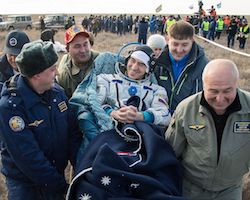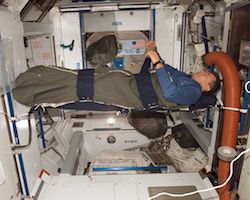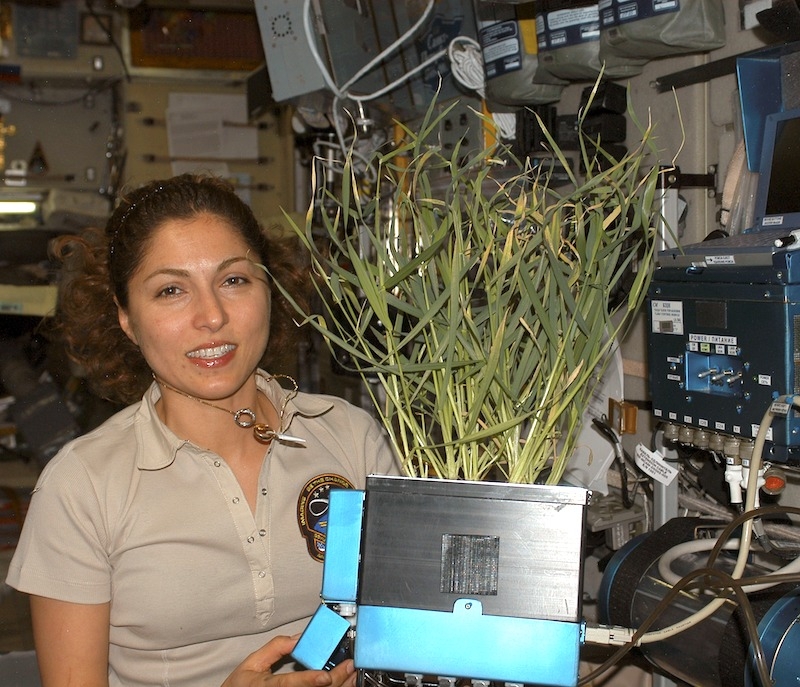
show/hide words to know
Astronaut: someone who has been trained to be a crew member of a spacecraft. ... more
Capsule: the part of a spacecraft that has been designed to hold the crew and survive re-entry into the Earth's atmosphere. ... more
Cosmic radiation: high-energy radiation (energy waves or particles) that mostly comes from outside of our galaxy. ... more
Mission: a specific travel assignment or trip into space.
Thruster: a small engine on a spacecraft that is used to make small adjustments to direction of travel. ... more
Challenges to Human Spaceflight
You wake up on day 180 of your mission, working on the International Space Station. For the last 6 months, you’ve been growing lettuce plants in the low-gravity environment of space. You did very well, and the next group of astronauts will continue the studies of your lettuce plants. But for now, it is time for you to return to Earth.
 The capsule departs the station, gently firing its thrusters. The capsule starts to enter the Earth’s atmosphere. It deploys its parachute and lands on the ground with a loud thump. Now that you are out of free fall, you can feel Earth’s gravity pulling you down. It’s a force you have not felt in 6 months, and you realize how much your body has changed since you first left. Like other astronauts before you, you will be carried by fellow humans away from the capsule to prevent breaking any bones. It will take a few months to regain all of your strength.
The capsule departs the station, gently firing its thrusters. The capsule starts to enter the Earth’s atmosphere. It deploys its parachute and lands on the ground with a loud thump. Now that you are out of free fall, you can feel Earth’s gravity pulling you down. It’s a force you have not felt in 6 months, and you realize how much your body has changed since you first left. Like other astronauts before you, you will be carried by fellow humans away from the capsule to prevent breaking any bones. It will take a few months to regain all of your strength.
Our bodies are not made for low-gravity environments. Our muscles, bones, hearts, and other systems function differently in space than they do here on Earth. For example, because our bodies are adapted to the pull of gravity on Earth’s surface, we have body systems that move fluid from our legs (where it can pool due to gravity) to our chests and heads.
 In space, the pull of gravity is very low. These systems can often remove too much fluid from our legs and put it into our chests and heads. Astronauts can then experience motion sickness, loss of balance, and loss of taste and smell. More concerning is the distortion of the fluid in human eyes, which can cause distorted vision. Our bodies can adapt to this redistribution of fluid, but it generally takes several weeks or months.
In space, the pull of gravity is very low. These systems can often remove too much fluid from our legs and put it into our chests and heads. Astronauts can then experience motion sickness, loss of balance, and loss of taste and smell. More concerning is the distortion of the fluid in human eyes, which can cause distorted vision. Our bodies can adapt to this redistribution of fluid, but it generally takes several weeks or months.
Long-term Effects of Space Travel
Longer term effects of low gravity include bone and muscle loss. Our bodies rely on gravity to tell which way to build our bones. In space, with no gravity to supply this direction, these bone growth systems break down. Also, astronauts typically don’t use certain muscle groups to support their bodies in microgravity. This causes a large amount of muscle to be lost in a short time. Astronauts can lose up 1% of their bone mass per month and as much as 20% of their muscle mass in about a week! These effects can be offset a little by rigorous daily exercise in space. Future human activity in space will require us to create new forms of exercise, including low gravity sports. Can you think of any sports that might be fun in low gravity?
Very long missions can also introduce health risks from cosmic radiation. This hazard has not been well-studied because it only affects humans after a very long time outside of the Earth’s magnetic field. The main danger from this type of radiation is the breaking of DNA in human cells. We may be able to reduce this risk in the future by adding more shielding to spacecraft.
 Finally, the mental stresses of being in space can pose a risk to human health and safety. The disconnect from loved ones on Earth and the cramped nature of spacecraft can cause anxiety for astronauts. Astronauts also generally report about 2 hours less sleep when in space than when on the ground. This can contribute to feelings of stress.
Finally, the mental stresses of being in space can pose a risk to human health and safety. The disconnect from loved ones on Earth and the cramped nature of spacecraft can cause anxiety for astronauts. Astronauts also generally report about 2 hours less sleep when in space than when on the ground. This can contribute to feelings of stress.
Additional images via Wikimedia Commons. Image of Anousheh Ansari by NASA.
Astronaut Anousheh Ansari holds a plant grown on the ISS. Research about growing food in space will support future human space exploration.







